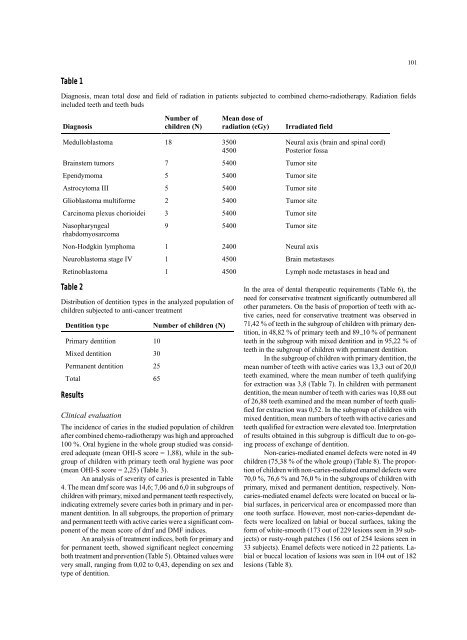Annals of Diagnostic Paediatric Pathology
Annals of Diagnostic Paediatric Pathology
Annals of Diagnostic Paediatric Pathology
Create successful ePaper yourself
Turn your PDF publications into a flip-book with our unique Google optimized e-Paper software.
101<br />
Table 1<br />
Diagnosis, mean total dose and field <strong>of</strong> radiation in patients subjected to combined chemo-radiotherapy. Radiation fields<br />
included teeth and teeth buds<br />
Diagnosis<br />
Number <strong>of</strong><br />
children (N)<br />
Mean dose <strong>of</strong><br />
radiation (cGy)<br />
Irradiated field<br />
Medulloblastoma 18 3500<br />
4500<br />
Neural axis (brain and spinal cord)<br />
Posterior fossa<br />
Brainstem tumors 7 5400 Tumor site<br />
Ependymoma 5 5400 Tumor site<br />
Astrocytoma III 5 5400 Tumor site<br />
Glioblastoma multiforme 2 5400 Tumor site<br />
Carcinoma plexus chorioidei 3 5400 Tumor site<br />
Nasopharyngeal<br />
9 5400 Tumor site<br />
rhabdomyosarcoma<br />
Non-Hodgkin lymphoma 1 2400 Neural axis<br />
Neuroblastoma stage IV 1 4500 Brain metastases<br />
Retinoblastoma 1 4500 Lymph node metastases in head and<br />
Table 2<br />
Distribution <strong>of</strong> dentition types in the analyzed population <strong>of</strong><br />
children subjected to anti-cancer treatment<br />
Dentition type<br />
Primary dentition 10<br />
Mixed dentition 30<br />
Permanent dentition 25<br />
Total 65<br />
Results<br />
Number <strong>of</strong> children (N)<br />
Clinical evaluation<br />
The incidence <strong>of</strong> caries in the studied population <strong>of</strong> children<br />
after combined chemo-radiotherapy was high and approached<br />
100 %. Oral hygiene in the whole group studied was considered<br />
adequate (mean OHI-S score = 1,88), while in the subgroup<br />
<strong>of</strong> children with primary teeth oral hygiene was poor<br />
(mean OHI-S score = 2,25) (Table 3).<br />
An analysis <strong>of</strong> severity <strong>of</strong> caries is presented in Table<br />
4. The mean dmf score was 14,6; 7,06 and 6,0 in subgroups <strong>of</strong><br />
children with primary, mixed and permanent teeth respectively,<br />
indicating extremely severe caries both in primary and in permanent<br />
dentition. In all subgroups, the proportion <strong>of</strong> primary<br />
and permanent teeth with active caries were a significant component<br />
<strong>of</strong> the mean score <strong>of</strong> dmf and DMF indices.<br />
An analysis <strong>of</strong> treatment indices, both for primary and<br />
for permanent teeth, showed significant neglect concerning<br />
both treatment and prevention (Table 5). Obtained values were<br />
very small, ranging from 0,02 to 0,43, depending on sex and<br />
type <strong>of</strong> dentition.<br />
In the area <strong>of</strong> dental therapeutic requirements (Table 6), the<br />
need for conservative treatment significantly outnumbered all<br />
other parameters. On the basis <strong>of</strong> proportion <strong>of</strong> teeth with active<br />
caries, need for conservative treatment was observed in<br />
71,42 % <strong>of</strong> teeth in the subgroup <strong>of</strong> children with primary dentition,<br />
in 48,82 % <strong>of</strong> primary teeth and 89.,10 % <strong>of</strong> permanent<br />
teeth in the subgroup with mixed dentition and in 95,22 % <strong>of</strong><br />
teeth in the subgroup <strong>of</strong> children with permanent dentition.<br />
In the subgroup <strong>of</strong> children with primary dentition, the<br />
mean number <strong>of</strong> teeth with active caries was 13,3 out <strong>of</strong> 20,0<br />
teeth examined, where the mean number <strong>of</strong> teeth qualifying<br />
for extraction was 3,8 (Table 7). In children with permanent<br />
dentition, the mean number <strong>of</strong> teeth with caries was 10,88 out<br />
<strong>of</strong> 26,88 teeth examined and the mean number <strong>of</strong> teeth qualified<br />
for extraction was 0,52. In the subgroup <strong>of</strong> children with<br />
mixed dentition, mean numbers <strong>of</strong> teeth with active caries and<br />
teeth qualified for extraction were elevated too. Interpretation<br />
<strong>of</strong> results obtained in this subgroup is difficult due to on-going<br />
process <strong>of</strong> exchange <strong>of</strong> dentition.<br />
Non-caries-mediated enamel defects were noted in 49<br />
children (75,38 % <strong>of</strong> the whole group) (Table 8). The proportion<br />
<strong>of</strong> children with non-caries-mediated enamel defects were<br />
70,0 %, 76,6 % and 76,0 % in the subgroups <strong>of</strong> children with<br />
primary, mixed and permanent dentition, respectively. Noncaries-mediated<br />
enamel defects were located on buccal or labial<br />
surfaces, in pericervical area or encompassed more than<br />
one tooth surface. However, most non-caries-dependant defects<br />
were localized on labial or buccal surfaces, taking the<br />
form <strong>of</strong> white-smooth (173 out <strong>of</strong> 229 lesions seen in 39 subjects)<br />
or rusty-rough patches (156 out <strong>of</strong> 254 lesions seen in<br />
33 subjects). Enamel defects were noticed in 22 patients. Labial<br />
or buccal location <strong>of</strong> lesions was seen in 104 out <strong>of</strong> 182<br />
lesions (Table 8).
















